VAGAL NEUROPATHY, VOCAL CORD WEAKNESS, AND REFERRED OTALGIA
KEY POINTS
- Computed tomography including computed tomographic angiography is the primary tool for looking for a structural cause of a cranial neuropathy that is likely to involve the skull base or more distal course of the nerve in question.
- Magnetic resonance imaging should be used if the pathology likely localizes to the brain stem or cisternal segment of the nerve(s) in question.
- Magnetic resonance imaging and magnetic resonance angiography cannot be trusted to confidently exclude all conditions that may lead to these neuropathies.
- The causative pathology may be of the end organ or other structures innervated by the nerve rather than the nerve itself.
- Diagnostic imaging, even performed optimally, fails to find a reason for these neuropathies in many patients.
INTRODUCTION
Clinical Presentation
The vagus, glossopharyngeal, spinal accessory, and hypoglossal nerves and cervical sympathetic plexus may be considered as a unit as well as individually. Although one of these may dominate the clinical presentation, more than one will often be involved following careful clinical testing. When more than one nerve is affected, and possibly associated with other symptoms or neurologic deficits, localization may be much easier and a very “directed” and concise imaging evaluation is possible. However, some situations require a comprehensive imaging study of nearly the entire head and neck region and sometimes the upper chest. For instance, cranial nerve (CN) X and cervical sympathetics have a long course between the brain and skull and the chest, and CNs IX and X have important pathways of referred pain. Such considerations and combinations of clinical findings may affect the imaging approach to identify the source of a patient’s presenting complaints and deficits. This clinically responsive tactical approach should become apparent later in this and in Chapters 137 and 139 through 141.
Sometimes, lesions outside the expected course of the nerves or those involving end organs will be the source of symptoms—for example, a pyriform sinus carcinoma causing ear pain that is referred along the vagus nerve or a submucosal laryngeal cancer causing “apparent” true vocal cord paralysis. It is critical to understand all of the neurologic deficits and complaints that might arise from these nerves to enable effective imaging and interpretation of the images.
In this light, a proximal injury to the vagus nerve may also involve the IX, X, XI complex as well as CN XII causing a complex vagal neuropathy with oropharyngeal signs and symptoms and hoarseness. More distal vagal or recurrent laryngeal nerve lesions will create isolated vagus nerve symptoms manifesting as hoarseness and aspiration secondary to vocal cord dysfunction. The combination of a vagal and sympathetic neuropathy usually occurs due to a structural lesion at the skull base or at the thoracic inlet.
Common general clinical presentations that may involve the various segments of the vagus nerve are outlined as follows:
Lesions Within the Skull
- Brain stem and extra-axial lesions in the low cerebellopontine angle and medullary cisterns may present as lower CN deficits. Intra-axial lesions will almost always be accompanied by some sensory or motor symptoms and related physical findings.
Jugular Fossa Syndromes
- Several French eponyms have been applied to clinical findings when three, four, or five (if the sympathetics are included) members of this group of nerves are involved. These include Vernet syndrome (IX–XI), Collet-Sicard syndrome (IX–XII), and Villaret syndrome (IX–XII and the sympathetic plexus).
- French eponyms are mentioned because they are occasionally presented as an indication for the imaging procedure; however, it is more useful to describe the specific nerves at risk. If three of the five are involved, the lesion will be at or near the skull base. The lesion will usually be somewhere between the medullary cistern–jugular fossa region and the posterior belly of the digastric muscle. If just two are involved, the lesion could lie in this relatively confined space in and around the skull base but a more comprehensive imaging evaluation often becomes necessary.
Referred Otalgia
- Referred otalgia is a very important symptom in upper aerodigestive tract disease, and it will come to imaging if progressive. Once temporomandibular joint syndromes, salivary gland, and similar sources of pain that may have a periauricular location been excluded clinically, it is important that these patients also have a complete clinical evaluation of the nasopharynx, oropharynx, and hypopharynx as well as otoscopy by an experienced otolaryngologist. Depending on this initial triage, they may be referred for imaging.
- Otalgia may come from middle ear disease caused by eustachian tube dysfunction, such as that caused by nasopharyngeal carcinoma. Referred otalgia may be via CN IX from the tongue base or tonsil or via CN X from the pyriform sinus. The cause, if found, may be and usually is a cancer at one of these sites. Progressive, possibly referred, otalgia must be viewed with a very high index of suspicion even in light of negative upper aerodigestive tract endoscopy especially in the smoking/drinking population. Glossopharyngeal neuralgia is, in reality, intense throat pain but may be lumped in this group since referred otalgia may be an accompanying complaint. This is discussed more completely and illustrated in Chapter 137.
Vocal Cord Paresis
- Once laryngeal cancer is excluded by indirect or direct laryngoscopy and a chest film is obtained to exclude obvious lung or mediastinal pathology, one must decide whether to take the imaging evaluation any further. If the vocal cord paresis is accompanied by a deficit in one or more of CN IX, XI, or XII, then the posterior fossa, skull base, and deep spaces down to the posterior belly of the digastric muscle must be covered. If the only other deficit is of the cervical sympathetics (Horner syndrome), then the lesion may lie between the skull base and thoracic inlet, and other accompanying symptoms such as a brachial plexopathy helps direct the examination.
- If the only symptom is hoarseness and the only sign is an atrophic, paralyzed, or paretic true cord, a cause is most frequently not found by imaging. However, the cause may be found as a submucosal mass or other derangement within in the larynx or adjacent hypopharynx (Fig. 138.1A–C). The vocal cord paresis may be the only sign of conditions as diverse as vagal cisternal segment compression due to a posterior fossa meningioma, a subtle mass in the thyroid gland or mediastinum causing compression or infiltration of the recurrent laryngeal nerve in the tracheoesophageal groove or aortopulmonary window, or even an aortic dissection in the absence of chest pain (Figs. 138.1D–J and 137.2–137.7).
APPLIED ANATOMY
Cranial Nerve Nucleus and Cisternal Segment
CNs IX, X, and XI share nuclei of the medulla (Figs. 137.2A–C and 138.2A,E). Motor fibers of all three nerves originate in the nucleus ambiguus dorsal to the inferior olivary nucleus. The dorsal nucleus of the vagus nerve supplies visceral motor fibers. Sensory fibers of CNs IX and X arise from their superior and inferior ganglia at the level of the jugular foramen and enter the brain stem between the medullary olives and the inferior cerebellar peduncle. The fibers course in the tractus solitarius and end in the nucleus solitarius. Once they leave the medulla oblongata at the posterolateral margin, all roots traverse the basal cistern, sometimes conjoined.
Foraminal/Skull Base Segment
The more medial and smaller of the two jugular fossa compartments known as the pars nervosa contains the terminus of the inferior petrosal sinus and the glossopharyngeal nerve (CN IX) (Figs. 104.10A–C and 138.2B,E). The more lateral of the two known as the pars vascularis is larger and contains the jugular bulb, vagus nerve (CN X), and spinal accessory nerve (CN XI). Within the jugular foramen, CN X gives off the auricular branch (the Arnold nerve), supplying sensory fibers to the external ear, external auditory canal, and inferior tympanic membrane. Just after leaving the jugular fossa, there will be one or two ganglia called the superior and inferior (nodose) ganglia of CN X.
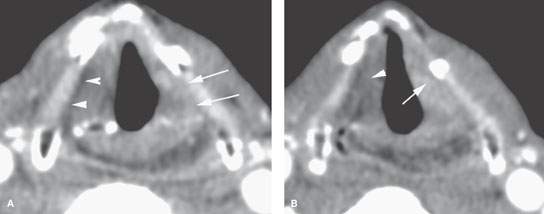
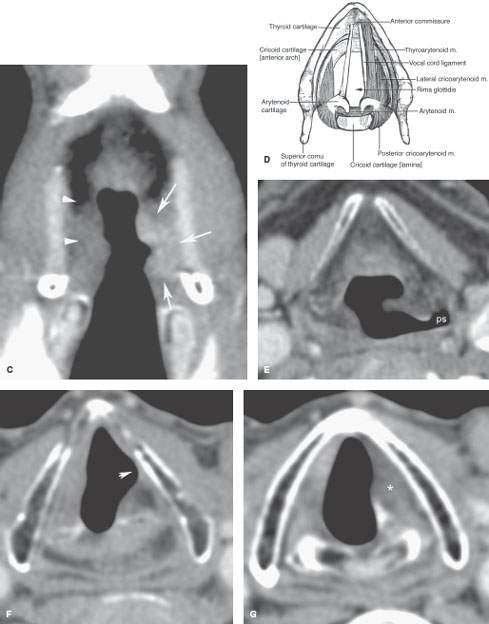

FIGURE 138.1. A–C: A patient presenting with hoarseness and vocal cord paralysis as a sign of a submucosal squamous cell carcinoma of the laryngeal ventricle and false vocal cord. The cancer is seen as infiltration of the paraglottic fat (arrows) compared to the normal opposite side (arrowheads). D–I: Understanding the imaging features of vocal cord paralysis. In (D), an anatomic drawing of the intrinsic laryngeal muscles is shown. In (E) through (I), vocal cord paralysis causes decreased density and volume loss (fatty atrophy) of the thyroarytenoid muscle, which forms the true vocal cord (*), and the posterior cricoarytenoid muscle (white arrow in H). During quiet respiration, a paramedian (adducted like) position of the paralyzed vocal cord is usually present, while the normal cord is slightly abducted in its “resting position.” The ipsilateral laryngeal ventricle (arrowhead) and pyriform sinus (ps) are widened. (Courtesy G. de Temmerman and A. Z. Klina, Antwerp, Belgium.) (continued)
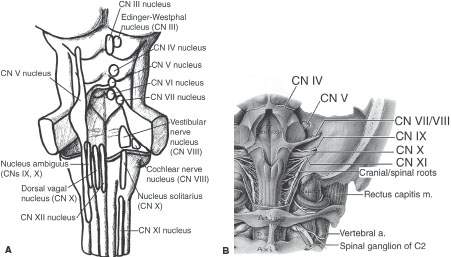
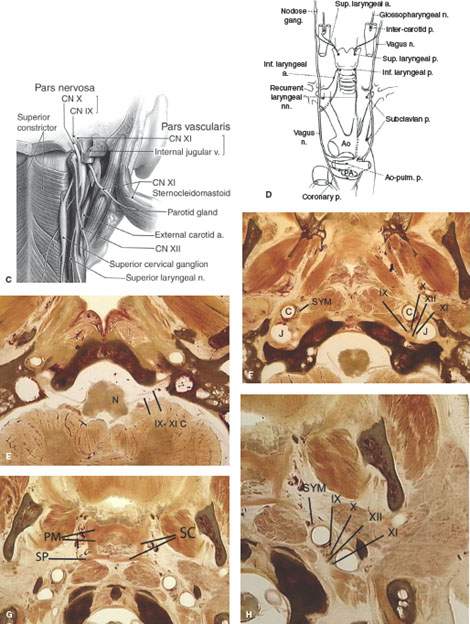
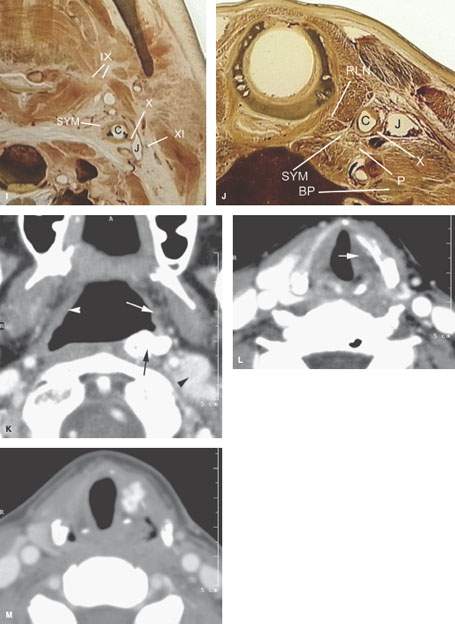
FIGURE 138.2. Anatomy of the vagus nerve. A–D: Anatomic drawings of the brain stem nuclei (A), cisternal (B) and foraminal (C) segment, and peripheral segment, giving off laryngeal branches (D). E–J: Anatomic sections from the brain stem to the level of the cricoid. The vagus runs from its nucleus in the medulla oblongata through the medullary cistern to the pars vascularis of the jugular foramen. Extracranially, cranial nerve (CN) X courses within the carotid sheath of the retrostyloid parapharyngeal space, the space also contains CNs IX, XI, and XII as well as sympathetics. CN X gives off branches to innervate the pharynx (together with CN IX and sympathetic trunk) and the larynx. (N, brain stem nucleus; c, carotid artery; j, jugular vein; SYM, sympathetic plexus; SC, superior constrictor muscle; PM, palatopharyngeus muscle; SP, stylopharyngeus muscle; RLN, recurrent laryngeal nerve; P, phrenic nerve; BP, brachial plexus.) K–M: Anatomic effects and treatment of those deficits. In (K), the carotid sheath paraganglioma (black arrowhead) produced a vagal neuropathy, causing the pharyngeal constrictor to become atrophic (white arrow) compared to the normal side (white arrowhead), so an injection (black arrow) had to be made to aid with pharyngeal closure. In (L) and (M), the vocal cord atrophy (arrow in L) was treated by injection (M) to help preserve glottic competence.
Stay updated, free articles. Join our Telegram channel

Full access? Get Clinical Tree








